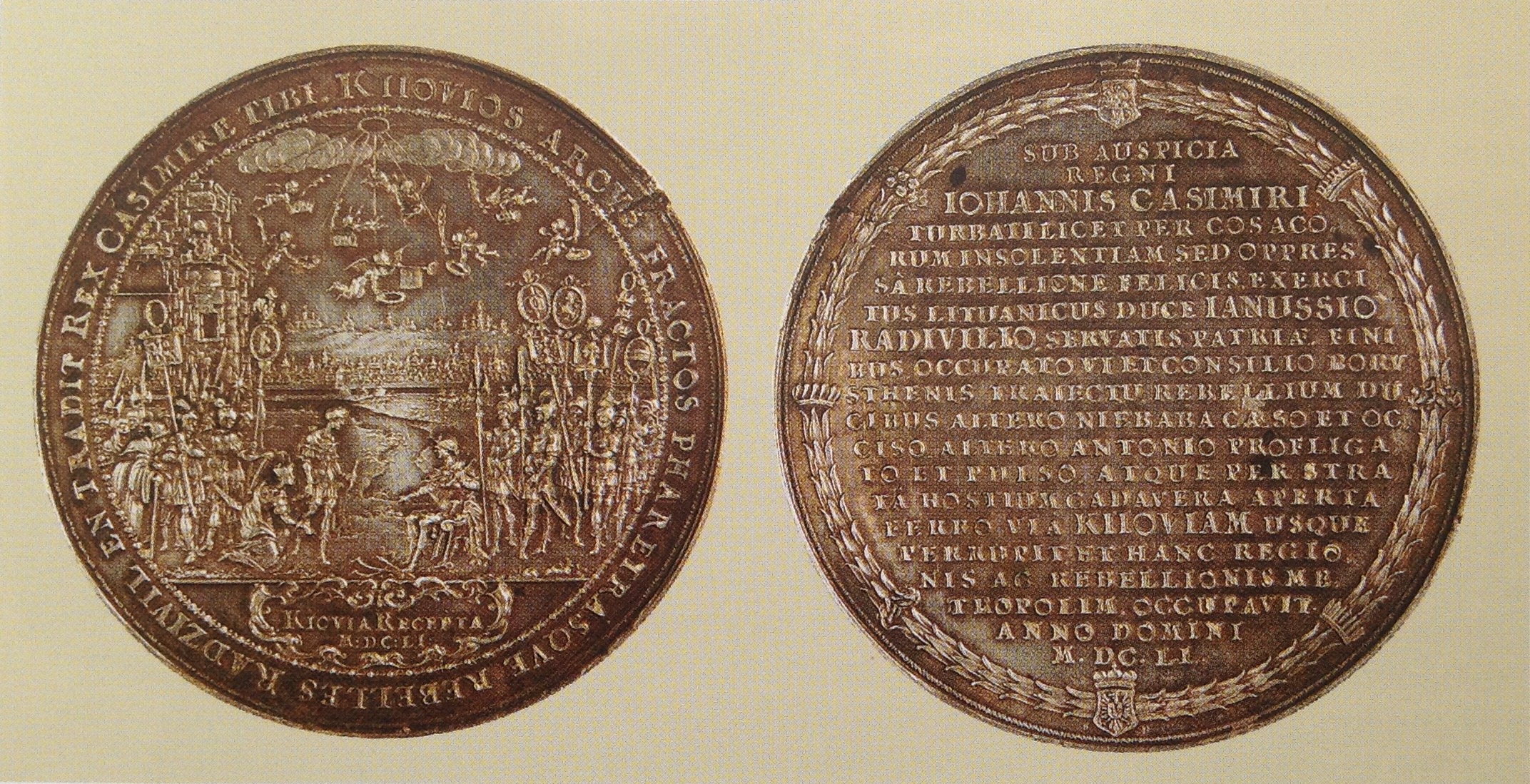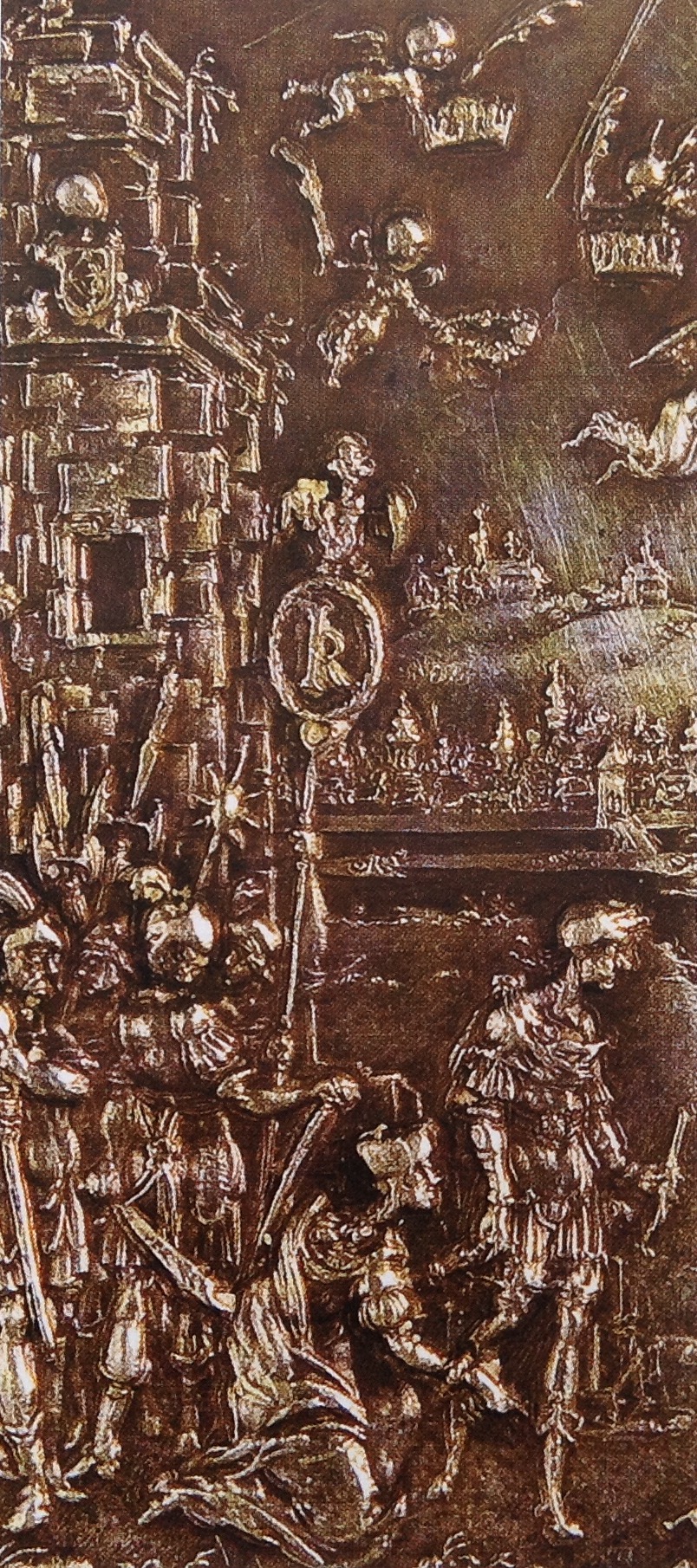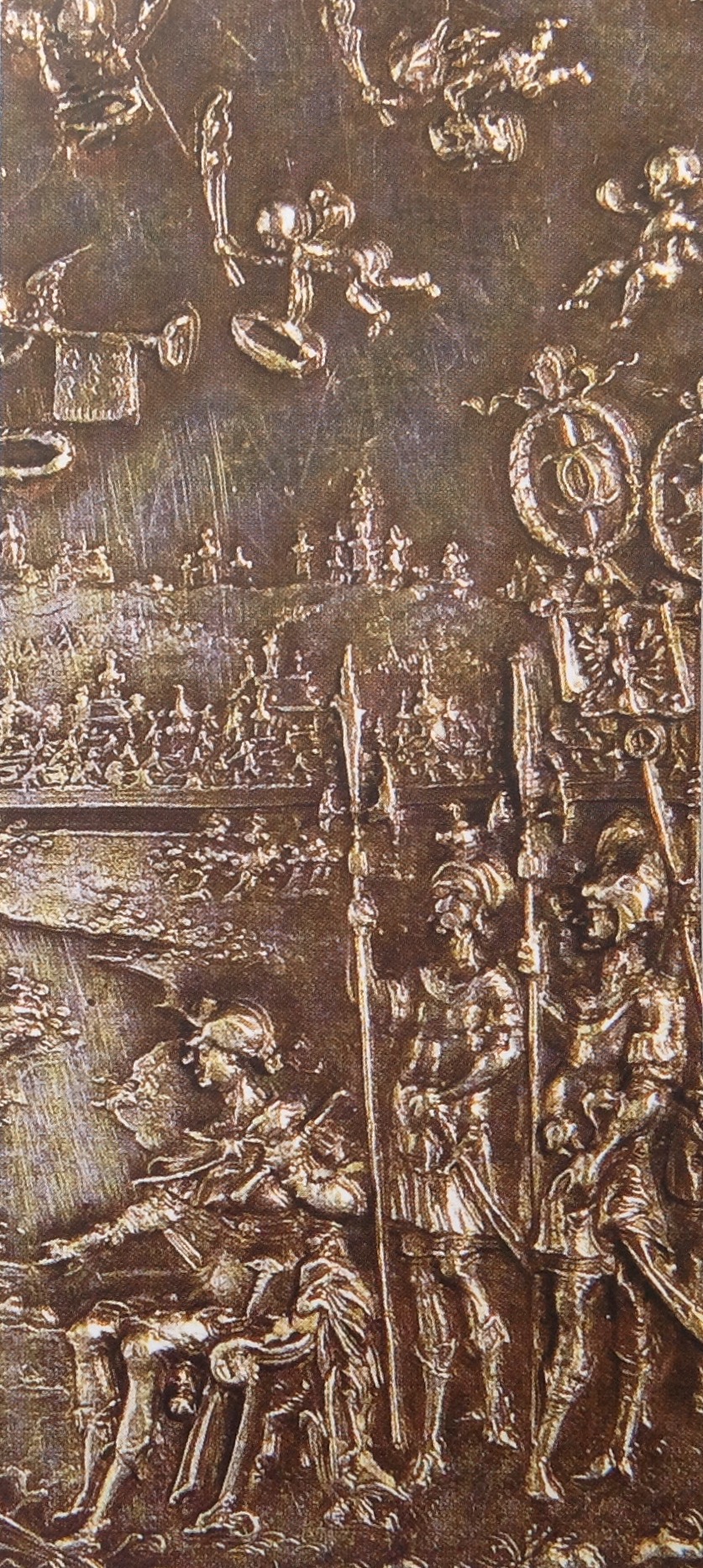Medal commemorating the conquest of Kyiv by the Lithuanian hetman Janusz Radziwill.
«Kiovia Recepta. MDCLI» (Kyiv fortress. 1651).
Sebastian Dadler.
Poland, 1652.
875 silver; stamping.
Diameter 6.8 cm.,
Weight 79.9 g.
Museum of History of Kyiv.
The sketch of the medal's image was done by Dutch graphic artist Abraham van Westerfeld, who served under the Lithuanian hetman Janusz Radziwiil during his rule over Kyiv in 1651.
Westerfeld's task was to render the victories of J. Radziwiil in an artistic manner. This mission inspired Westerfeld to create interesting images of mid-17th-century Kyiv landmarks such as the St. Sofia Cathedral and the Golden Gates, as well as the scenery of the Kyiv-Pechersk monastery caves. These are the oldest authentic images of the city.
The medal was carved by Sebastian Dadler (1586-1657). Born in the French city of Strasbourg, Dadler studied medal art in Augsburg, Germany. Later, he worked in France, in the Netherlands, in many German cities of the Holy Roman Empire and in Poland and Denmark. Westerfeld died in Hamburg and was buried there.
The commemorative medal in honor of the conquest of Kyiv was made by Dadler in the free Polish city of Gdansk (Danzig) not earlier than in 1652. Coinage of the medal took place at the Gdansk mint.
The medal was made from 875 silver by stamping. (It is also known that there are versions of the medal made from gold.) It was purchased by the museum in 1987 from a Kyiv resident who may have obtained it as a military trophy in 1944-1945.
The copy that is kept in the collection of the Museum of History of Kyiv was discovered in 1992. Until that time, there were five known copies of the medal, kept in the Hermitage, the Wroclaw Museum of Medal Art, the museums of Krakow, Kobekhov, and Munich. In 2002, a new, seventh copy was discovered in a private collection in Kyiv, identical to the medal from the Kyiv Museum of History collection and with a similar stamping defect - a crack.
Obverse. Set against a Kyiv panorama, a symbolic solemn ceremony is depicted in which the city keys are being transferred from Janusz Radziwiil to the Polish king Jan II Casimir Vaza. Both figures, as well as the troops around them, are dressed in armor of an antique motif.The troops on the king's side hold banners with the following images: the emblem of Poland, an eagle with a laurel wreath containing the king's initials «l» «S» in Latin; one of the emblems of Sweden, a Gothic lion; and «the sheaf» coat of arms (a bundle of rye was the coat of arms of the Swedish royal house of Vazas, to which Jan II Casimir belonged). The fourth banner around the king contains another emblem of Sweden: three crowns, signifying the number of historical localities forming the country. On the fifth banner is an emblem of Jan Casimir's mother, Princess Constance of Austria. The troops at the side of Field Hetman Radziwiil hold two banners with the coat of arms of the Grand Duchy of Lithuania - «Pogon.»The hetman's initials «J» and «R» are contained in the laurel wreath above, as well as the emblem of the Radziwiil family - an eagle with three horns.

Janusz Radziwiil holds a kneeling woman by the hand.The woman is dressed in the Euro- pean urban clothes of the 17th century. Her head is adorned with a tower crown, a traditional symbol of the city from the times of antiquity. The allegorical figure of a woman per- sonifies the defeated Kyiv fortress. This is explained in the first line of the Latin inscription, contained in the cartouche below her figure: «Kiovia Recepta.»The second line provides the date when the fortress fell: «M:DC:LI.» The cartouche ringlets hide the initials of medallist Sebastian Dadler - «S» and «D.»
 
Three objects symbolizing Kyiv are depicted on the medal: a geographical symbol, the river Dnipro; a historical-architectural symbol, the Golden Gates ruins of the Old Rus' time; and the coat of arms of Kyiv as a Magdeburg city of the 16th to the 18th centuries - «kusha» (arbalest). The coat-of-arms shield is held by one of the seraphs; others, in accordance with the solemnity of the event and with European art canons at the time, soar above the troops, holding palm branches and laurel wreaths while one of them plays the bugle. There are broken bows and quivers scattered on the field around the troops.

A circular inscription in Latin explains the content of the scene: «REBELLES RADZIVIL EN TRADIT REX CASIMIRE TIBI.» (Radziwill hands you, King Casimir, the Kyiv broken bows and mutinous quivers).
Reverse. Inside a laurel wreath with shields carrying emblems of the Polish kingdom and the Grand Duchy of Lithuania is a 20-line inscription: «SUB AUSPICIA / REGNI / I0HANNIS CASIMIRI. / TURBATILICET PER COSACOK / RUM INSOLENTIAM, SED OPPRESK / SA REBELLIONE FELICIS, EXERCIK / TUS LITUANICUS DUCE IANUSSI0 / RADIVILLO, SERVATIS PATRDK FINIK / BUS, OCCUPATO VI ET CONSILIO BORVK / STHENIS TRATECTU, REBELLIUM DUK / ClBUS ALTERO NIEBABA CA SO ET OCK / CISO. ALTERO ANTONIO PROFLIGAK / TO ET PULSO, ATQUE PER STRAK / TA HOSTIUM CADAVERA APERTA / FERRO VIA KIIOVIAM USQUE / PERRUPIT, ET HANC REGIO / NIS AC REBELLIONS ME / TROPOLIM, OCCUPAVIT. / ANNO DOMINI / M. D.C. L.l.» (Brave and loyal son of his Motherland Janusz Radziwill defeated the mutinous Cossacks and returned peace and prosperity to Kyiv and the neighboring provinces. 1651.). Below, under the wreath, are the initials of Sebastian Dadler: «S» and «D.»The medal rim is smooth, with no impressions.
The scene represented on the medal is a free artistic allegory. In reality, the solemn handover of Kyiv by Janusz Radziwill to the Polish king never took place; moreover, Jan II Casimir had never been to Kyiv. Radziwill's army entered the city freely; the Cossacks left the city without a fight in accordance with an arrangement facilitated by the Kyivan metropolitan bishop Silvestr Kosov.The main condition of the handover was a guarantee from Radziwill's faction that the Lithuanian army would not use repression or loot the city. On July 23,1651, the leading detachment of 3,000 troops headed by Wojciech Gonsiewski entered the city, and only on July 25 did the field hetman arrive with an army three times greater. This fact resulted in the emergence of a sarcastic paraphrase of the medal's inscription among the nobility: «Gonsiewski hands you, Prince Radziwill, the Kyiv broken bows and mutinous quivers.» Nevertheless, the depicted scene is close to the historical reality. The city keys were presented to the victor at the Golden Gates (on the square in front of Sofia?). Contemporaries of those events report this in their records. The distastefullness of this fact for Kyiv residents is reflected in the themes of Westerfeld's drawings, which capture the solemn entrance of the Lithuanian hetman and the greeting by the city's inhabitants, led by the metropolitan bishop and the patricians. Several of the figures hold flags; others have lowered them. Some of the Kyiv and Cossack flags were afterwards presented to the king and were kept in Warsaw, although they were later transported (in 1655-1660) to Sweden as military trophies. One of the Kyiv flags has survived. Within a month, the Lithuanian army left Kyiv in accordance with the conditions of the Bila Tserkva agreements, and control of the city was returned to the administration of Bohdan Khmelnytskyi.
Kyiv & Ukraine Private Tour Guide
|